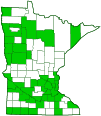plains clubtail
(Gomphurus externus)
Conservation • Description • Habitat • Ecology • Distribution • Taxonomy
Conservation Status |
|
|||||||
| IUCN Red List | not listed |
|||||||
| NatureServe | N5 - Secure SNR - Unranked |
|||||||
| Minnesota | not listed |
|||||||
Description |
||
Plains clubtail is a medium-sized to large dragonfly. It occurs in the United States from Ohio west to eastern Idaho, north to Minnesota, and south to Louisiana and New Mexico. It also occurs in southern Winnipeg and Saskatchewan Canada. It is relatively common in Minnesota. It is found at large, moderately flowing rivers and large streams with muddy bottoms and grassy or wooded banks. It is occasionally found at lakes. Adults are active from early April to mid-August. They will eat almost any flying insect. The larvae are aquatic. They eat aquatic insects, freshwater shrimp, small fish, and tadpoles. Adults are 2 1⁄16″ to 2⅜″ (52 to 60 mm) in length. The body is stocky, heavily clubbed, and brownish-black with extensive bright yellow markings. The head is small. The plate on the face (clypeus) is crossed in the middle by a transverse groove called the frontoclypeal suture. There is no black band on the face, but the frontoclypeal suture may appear as a dark hairline. The large compound eyes are turquoise blue and do not meet at the top of the head on either sex. The area behind the compound eyes at the top of the head (occiput) on both sexes is yellow. On the female there is a short, yellow, laterally slanting horn next to each compound eye in front of the occiput. The thorax is large and black with yellow stripes. On the upper side there is a pair of stripes (dorsal top stripes). Each stripe has an inward, bar-like extension at the top that meets the other stripe, and an outward, hook-like extension at the bottom. On the sides of the thorax there is a thin gray upper stripe in the shoulder area, two widely separated yellow stripes, and a gray stripe between the yellow stripes. The gray stripes are variable. The upper gray stripe varies in length from long and complete, connecting with the dorsal top spot at the bottom, to short and incomplete. The lower gray stripe is variable in width. On the abdomen there are yellow spots on top of all segments. There is a lance-shaped spot on segments 1 through 7 (S1 to S7), a triangular spot on S8, a rectangular spot on S9, and a small dot on S10. S7, S8, and S9 are expanded into a noticeable, moderate-sized “club”. The sides of S8 and S9 have large yellow spots that reach the edges. On S8 the spot is mostly complete. On S9 the spot is the entire length of the segment. At the tip of segment 10 the male has claspers used to grasp the female during mating. The claspers consist of a pair of upper appendages (cerci) and a single lower appendage (epiproct). The claspers are very widely forked. The epiproct is wider than the cerci when viewed from above, and it extends well beyond the cerci. The female also has cerci on S10, but they are non-functional and tend to break off. The legs are black. On the female, the third leg segment (femur) often has a yellow stripe. On both sexes, the fourth leg segment (tibia) has a pale yellow stripe near the base. The wings are clear except for a dark cell (stigma) on the leading edge (costal margin) near the tip. The vein on the costal margin (costa) of each wing is bright yellow. |
||
Size |
||
Total length: 2 1⁄16″ to 2⅜″ (52 to 60 mm) |
||
Similar Species |
||
Pronghorn clubtail (Phanogomphus graslinellus) is very similar but smaller. S9 is all yellow above. S10 has more yellow above. On the male it has a yellow stripe. On the female it is mostly yellow. On the male, the epiproct extends barely beyond the cerci. |
||
Habitat |
||
Large, moderately flowing rivers; large streams with muddy bottoms and grassy or wooded banks;.and occasionally lakes |
||
Ecology |
||
Season |
||
Early April to mid-August |
||
Behavior |
||
When near water, males will perch on the shore, on rocks exposed above water, or lacking these, on overhanging vegetation. When away from water, they will perch on the ground or at the tips of weeds. They make a long, wide, surveying patrol far over water and return to their perch. Males fly with their club raised. The flight is bouncy. |
||
Life Cycle |
||
|
||
Naiad Food |
||
Aquatic insects, freshwater shrimp, small fish, and tadpoles |
||
Adult Food |
||
Flying insects |
||
Distribution |
||||
|
Sources Haarstad, J. 1997. The dragonflies of selected eastern Minnesota rivers. Report submitted to the Minnesota Department of Natural Resources. Unpaged. |
|||
| 10/21/2022 | ||||
Occurrence |
||||
Fairly common |
||||
Taxonomy |
|||
Order |
Odonata (dragonflies and damselflies) | ||
| Suborder | Anisoptera (dragonflies) | ||
Superfamily |
Gomphoidea | ||
Family |
Gomphidae (clubtails) | ||
Genus |
Gomphurus | ||
Superfamily Genus |
|||
Synonyms |
|||
Gomphus externus |
|||
Common Names |
|||
plains clubtail |
|||
Glossary
Cercus
One of a pair of small sensory appendages at the end of the abdomen of many insects and other arthropods. In Odonata, one of the upper claspers. Plural: cerci.
Clypeus
On insects, a hardened plate on the face above the upper lip (labrum).
Costa
On ferns: The central axis of a pinna, to which pinnules are attached. On mosses: the central axis (midvein) of a leaf. On insects: The vein on the leading edge of the forewing.
Costal margin
The leading edge of the forewing of insects.
Epiproct
In Odonata, the lower clasper at the tip of the male abdomen.
Femur
On insects and arachnids, the third, largest, most robust segment of the leg, coming immediately before the tibia. On humans, the thigh bone.
Occiput
The back of the head. In Odonata, Megaloptera, and Neuroptera, the upper part of the head behind the eyes.
Stigma
In plants, the portion of the female part of the flower that is receptive to pollen. In Lepidoptera, an area of specialized scent scales on the forewing of some skippers, hairstreaks, and moths. In other insects, a thickened, dark, or opaque cell on the leading edge of the wing.
Tibia
The fourth segment of an insect leg, after the femur and before the tarsus (foot). The fifth segment of a spider leg or palp. Plural: tibiae.
Visitor Photos |
|||||
Share your photo of this insect. |
|||||
| This button not working for you? Simply email us at info@MinnesotaSeasons.com. Attach one or more photos and, if you like, a caption. |
|||||
Dan W. Andree |
|||||
Dragonfly feeding... … it is eating … a painted lady.
|
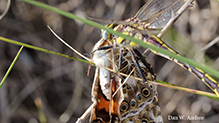 |
||||
I often see dragonflies on prairies even dry prairies. Guessing they travel once they can fly in search of food even away from water sources at times. Dragonflies have big eyes and some are colorful. |
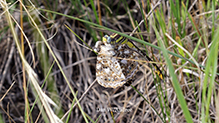 |
||||
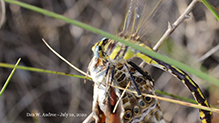 |
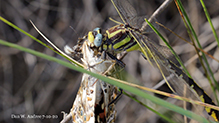 |
||||
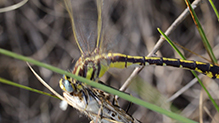 |
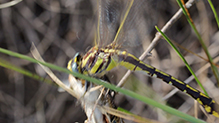 |
||||
MinnesotaSeasons.com Photos |
|||||
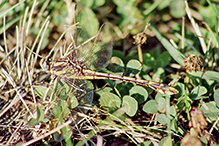 |
|||||

Slideshows |
||
| Plains Clubtail Victor Fazio |
||

|
||
About
A gallery of Gomphurus externus, Plains Clubtail in the family Gomphidae. |
||

Visitor Videos |
|||
Share your video of this insect. |
|||
| This button not working for you? Simply email us at info@MinnesotaSeasons.com. Attach a video, a YouTube link, or a cloud storage link. |
|||
Dan W. Andree |
|||
| "Plains Clubtail Dragonfly" eating a butterfly Nov 2, 2023 |
|||
About
The title kind a says it. I just happen to notice this dragonfly and upon closer inspection realized what it was doing |
|||
Other Videos |
|||
| Plains Clubtail Dragonfly (Gomphidae: Gomphurus externus) Close-up Carl Barrentine |
|||
About
Uploaded on Jun 25, 2011 Photographed at Grand Forks, North Dakota (24 June 2011). |
|||
| Plains Clubtail (Gomphidae: Gomphurus externus) Male Carl Barrentine |
|||
About
Uploaded on Jun 14, 2010 Photographed at East Grand Forks, Minnesota (13 June 2010). |
|||
| Plains Clubtail (Gomphidae: Gomphurus externus) Male Carl Barrentine |
|||
About
Uploaded on Jul 6, 2009 Photographed at East Grand Forks, Minnesota (06 July 2009). |
|||

Created 2/16/2012
Last Updated:
